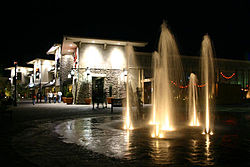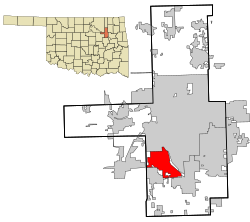Jenks, Oklahoma
| Jenks, Oklahoma | |
|---|---|
| City | |

Riverwalk Crossing on the Arkansas River, Jenks
|
|
 Location within Tulsa County, and the state of Oklahoma |
|
| Coordinates: 36°0′37″N 95°58′47″W / 36.01028°N 95.97972°WCoordinates: 36°0′37″N 95°58′47″W / 36.01028°N 95.97972°W | |
| Country | United States |
| State | Oklahoma |
| County | Tulsa |
| Area | |
| • Total | 17.73 sq mi (45.9 km2) |
| • Land | 17.13 sq mi (44.4 km2) |
| • Water | 0.6 sq mi (1.6 km2) |
| Elevation | 617 ft (188 m) |
| Population (2013) | |
| • Total | 18,670 |
| • Density | 988.1/sq mi (434.0/km2) |
| Time zone | Central (CST) (UTC-6) |
| • Summer (DST) | CDT (UTC-5) |
| ZIP code | 74037 |
| Area code(s) | 539/918 |
| FIPS code | 40-37800 |
| GNIS feature ID | 1094209 |
Jenks is a city in Tulsa County, Oklahoma, United States, and a suburb of Tulsa, in the northeastern part of the state. It is situated between the Arkansas River and U.S. Route 75. Jenks is one of the fastest growing cities in Oklahoma. As of the 2000 census, the city population was 9,557, but by 2010, the population was 16,924, an increase of 77.1 percent.
Jenks began in 1904 as a community site established by the Midland Valley Railroad between Tulsa and Muskogee, alongside the Arkansas River. Though the river could only be utilized by shallow draft steamboats while the water level was up, these two transportation routes proved vital to Jenks' early development.
Jenks was named after William Henry Jenks the owner and director of the Midland Valley Railroad. According to a 1957 article in the Tulsa Tribune, an agent for the townsite company was told by the railroad home office to name a town for the director.
The town was officially platted on July 15, 1905. Also in 1905, a major petroleum discovery was made, further bolstering the economy of the area. The "Glenn Pool" oil well and subsequent oil claims brought many business people to the general area. In 1906, many oil depots (also known as "tank farms") were constructed in Jenks. By the time of statehood, Jenks had 465 inhabitants.
As oil production waned, tank farms were dismantled, and agriculture became once again a major contributor to the Jenks economy. The economy of the area was further improved in the 1920s when many Bulgarian families immigrated to the area to farm. These immigrants established many vegetable farms.
From 1904 through the 1950s, Jenks experienced many floods from the overflow of the Arkansas River and Polecat Creek. In the 1920s and 1930s floods were very severe. During one flood in the late 1920s the water was so deep that it completely covered every building but the roof of the three story high school. Everyone was evacuated except two men and one woman. They had one shotgun, one small boat, food and a tent on top of the school. They guarded the remains of Jenks for several weeks until the water receded. In 1948, the U.S. Army Corps of Engineers built a levee around Jenks, and the community subsequently grew as a result of the increased safety and security. There was another threat of severe flooding in 1986, when severe rainstorms upstream along the Arkansas River the Corps of Engineers to release as much as 300,000 cubic feet per second from the Keystone Dam into the river. This caused a mandatory evacuation order in Jenks and several other river communities.
...
Wikipedia
